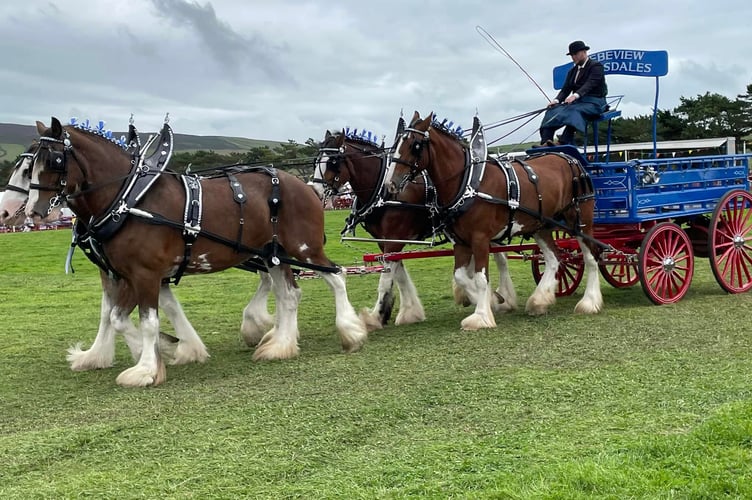One of the highlights at the summer agricultural shows is the presence of heavy, or draft, horses.
They are always beautifully presented – their manes and tails are plaited and ornately ‘ribboned’, and their feathers (the hair at the bottom of their legs) are thoroughly washed and brushed so that they seem to float in the breeze.
At last weekend’s Royal Manx Show there was the added attraction of heavy horses pulling a dray (an open cart) around the main arena, a reminder that these amazing creatures were integral to our transport system until the beginning of the 20th century.
There are three heavy horse breeds native to the British Isles: the Shire, the Clydesdale and the Suffolk Punch.
The foundation stallion of the Shire horse dates back to between 1755 and 1770, although large horses had been used for transportation and ploughing for several centuries before that time.
The horses were originally bred in the Shires of England, hence the name, and they remained in demand until after the Second World War when they played a massive role within the artillery.
After that, their numbers dwindled to a point where, in the 1950s, there were just a few thousand Shires left and they became classed as a rare breed.
The Clydesdale horse also dates back to the middle of the 18th century.
They were originally bred near the River Clyde in Lanarkshire, Scotland, from Flemish stallions imported from the continent.
Like the Shire, the Clydesdale’s numbers fell alarmingly after the Second World War but, thankfully, the decline in both breeds has now been halted and their numbers are building back up slowly.
Shire and Clydesdale horses look very similar, but there are differences: the Shire is generally larger and broader than the Clydesdale, and its body colouring is a solid black, roan, grey or brown with white feathers (a chestnut colouring is rare).
The Clydesdale is generally brown in colour, with white feathers, but it often has white colouring mixed into its coat.
The Suffolk Punch is always a chestnut colour, although the shade can vary from dark to light, and it has very few white markings if any at all.
It is smaller than the Shire or Clydesdale, with stocky, un-feathered legs, and therefore much easier to identify.
The breed is even older than the Shire or Clydesdale, and is described in detail as a ‘chesnut’ horse from East Anglia in literature dating back to 1586.
This makes it the oldest breed of horse recognisable in the same form today.
Farmers originally bred the Suffolk Punch (‘punch’ being an old English word for a short, stout person) and because they were so well suited to ploughing they kept the bloodlines relatively pure.
Despite the Suffolk Punch’s impressive history, it is now classed as the rarest horse breed in Britain, with numbers in the low hundreds (rarer than the Giant Panda).
Given its moderate size and relatively good agility, it can be ridden, and this adaptation of use may help to secure its future.
As with its Shire and Clydesdale cousins, these heavy horses are renowned for their gentle personalities and their willingness to work.
They are also hardy and, in comparison to ‘hot-blooded’ horses like thoroughbreds, they are easy to keep. All the heavy horse breeds are classed as ‘cold-blooded’ because of their calm temperaments, although in reality all horses have the same body temperature.
We have a very special horse looking for a long-term foster home.
She’s a six-year-old thoroughbred, but she doesn’t show ‘hot’ tendencies and she has a very sweet nature.
She would be an ideal companion horse (she’s a surprisingly good ‘doer’) but we can’t promise that she will be able to be ridden, although it is likely that she could be hacked out lightly.
Please contact the ManxSPCA for further details by e-mailing [email protected].

-(1).jpeg?width=209&height=140&crop=209:145,smart&quality=75)



Comments
This article has no comments yet. Be the first to leave a comment.